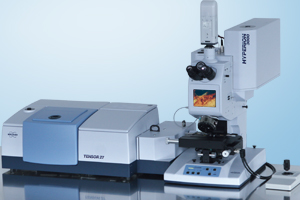| |
|
| Make |
: Bruker, Germany |
| Model |
: 3000 Hyperion Microscope with Vertex 80 FTIR System
|
| Specification |
:
Focal plane array: 128 x 128, range:4000-900cm-1.
Single point detector: range: 4000-450 cm-1.
Analysis area: 128x128 in 2D format on the sample plane 300x300 µm.
Accessories: Micro ATR, Grazing angle
Spatial resolution with 15x objective-2.7 µm.
20x objective (ATR):0.5 µm.
Temperature controlled sample stage.
Spectral resolution of FTIR 0.2 cm-1.
Rapid scan & step scan available. Rapid scan 65
spectra/sec at 16cm-1.
Library search for Organic compounds & polymers.
|
|
 |
Infrared Spectroscopy gives information on the vibrational and rotational modes of motion of a molecule and hence an important technique for identification and characterization of a functional; group.. The Infrared spectrum of an organic compound provides a unique fingerprint, which is readily distinguished from the absorption patterns of all other compounds.
|
|
FTIR Imaging is a complimentary Imaging tool and is a very versatile analytical technique for spectrochemical imaging. The advantage of chemical imaging compared to other sensor technologies is the ability to analyze the spatial distribution of the component materials in blends, granules or finished dosage forms. Many analysts need to obtain the molecular information from an area of a sample to see a picture of the distribution of molecules or functional groups. These chemical called IR images provide information, that is highly complementary to images obtained from techniques such as Scanning Electron Microscopy (SEM), Atomic Force Microscopy (AFM) and visible light microscopy. SEM and AFM have each a much higher spatial resolution than FTIR imaging, down to less than 1 nm. These techniques provide information about surface properties and in some cases, elements distribution, but they do not provide information about molecular composition. The chemical imaging approach has the potential to monitor processes to reveal the extent of ingredient blending, particle size distributions, agglomeration of component particles and the presence of polymorphs, hydrates and other trace contaminants.
Fourier Transform Infra-Red (FTIR) Spectroscopy is well proven as a sensitive, rapid technique for material characterization of various samples for molecular species in a broad range of materials. By coupling the FTIR to a microscope accessory, measurements on small sample can be routinely carried out, down to few micron area. Applications include the identification of trace contaminants, the analysis of failure modes and characterization of production defects.
Both FT-IR and FT-NIR take advantage of the fact that the functional groups of every module generate a characteristic absorption or transmission spectral fingerprint that definitely identifies that chemical compound. FTIR and FT-NIR are quickly becoming the preferred compound testing technologies because of their speed, accuracy and reliability. While infrared microscopy provides the highest sensitivity and widest spectral range for small area FTIR measurements, collecting microscopic chemical picture of your sample can be time consuming, depending on the data collection and sample size requirements. Unlike IR microscopes that employ a single detector measuring a single point at a time, FTIR imaging systems contain multi-element detectors, producing IR images almost as fast as an optical microscope presents a visible image.
|
1. Provide solid samples in powder form. Minimum amount required 1-2 mg.
2. Samples may be in liquid form. Minimum amount required 0.1 ml.
3. Samples can be submitted as thin films.
|
Contact : 022-2159 6869
Email Id : sonali@iitb.ac.in,
priyankaj@iitb.ac.in
|
|
FITR-Imaging System Charges excluding GST
|
| | Industry | University | National Lab/R&D's |
IITB User | | |
| FTIR Routine Spectrum | 1200/- | 240/- | 600/- |
120/- | Per Sample
|
| FAR-IR Spectrum | 1200/- | 240/- | 600/- |
120/- | Per Sample
|
| Single Point Spectra | 2250/- | 450/- | 1125/- |
225/- | Per Sample
|
| Focal Plan Array | 4500/- | 900/- | 2250/- |
450/- | Per Sample
|
|
|
